A couple o’ months back, I was stomping my way down to engineer a class in Sausalito and ended up pedaling the last few miles single-leggedly. (The initial post appeared here, and then I nattered more about it yonder.) Now, the fine folks down the peninsula at Ritchey Logic did address the problem quickly and effectively. It turned out that my initial left crank arm had been subject to a voluntary recall, as it had been built sub-spec (got one? ID yours with this handy Ritchey Design Voluntary Recall pdf ) They received the crank and had another one out to me within a scant few days. All good.
Well, yes and no.
Let me say a few things about the crankset. Because I really like the crankset, and it’s important to know that. They are light and have a comfortably narrow tread (“Q-Factor” AASHTA citation), use a 110mm BCD chainring and have generally done their work reasonably quietly and efficiently. But, dealing with these breaking has reminded me of a whole host of other memories and experiences concerning crankarms, their failures and the fact that manufacturers have really managed to go out of their way to complicate this part. For the most part, my frustration is with the general area of cranksets, a needlessly stormy sea in which these cranks just now happen to be swimming.
This whole discussion is multiplying and expanding in my brain right now - because the Ritchey cranks remind me of why I went with them in the beginning - replacing a reasonably high-zoot set which failed egregiously. I broke two of those. Or, more accurately, I had two sets catastrophically fail on me. That recollectioin got me thinking about the sheer number of chainrings that wore out on the mountain bike - especially during the El Nino years - ground what seemed to be too soon into nasty shark fin profiles, which reminded me of the grease-and-voodoo-incantations engaged in attempt to quiet the continually squawking but beyond elegantly beautiful Cook E2 cranks I had, and how those were horsetraded to switch over to the then-new Shimano XTR 4-bolt design, which had wonderfully meaty and long lasting chainrings. I loved that setup - until I priced replacement rings, which - I kid you not - were only a couple of movie and burrito nights difference in price from a new crankset with rings…!
I think what I really want is a set of steel cranks. But, I’m getting a bit ahead of myself.
It’s possible I have crankset issues. Didn’t really realize it until writing all these things out. I do hate to rant, but, dang it, there should be a simple solution for all of this stuff. It should work and be solid, hard to mung up, and not look like it was created by an art director. There should be an elegant solution. This should be available.
Man, it does seem that I’m all worked up over this. But, I don’t think I should have to buy a 10 year old set of cranks to solve this problem. Again, I digress. Back to the story.
The replacement arm arrived from Ritchey and was a “B” fit. In other words, it was tighter than what I sent back to them, and I had to really press it to set it onto the splined interface of the bottom bracket. These cranks - the Ritchey Cross Cranks (which curiously do not appear any longer on the RitcheyLogic.com website) use an “Octalink” design which Shimano brought forth to sunset the square taper design which was simple and proven, but non-proprietary. On the Octalink, the 8 splines should mesh like gears and prevent the crank from rotating on the bottom bracket spindle. Unlike a square taper, it should not really be a force fit.
I lined them up carefully, pushed them on as tightly as I could, then tightened the new arm down, then removed the bolt again to make sure it had seated correctly. Took a couple of short, post-flu rides on the bike and from about the middle half of the first ride, something felt funny on my left hip and low back. Then it would get better, then it would appear again. As I was negotiating some slow speed maneuvers, coasting with the cranks level, there was a definite shift in the left crank arm. Flipping to the other foot forward, I felt it again.
Got home, broke out the good camera and took an image of the worst of it. Digital straight-edge added for reference: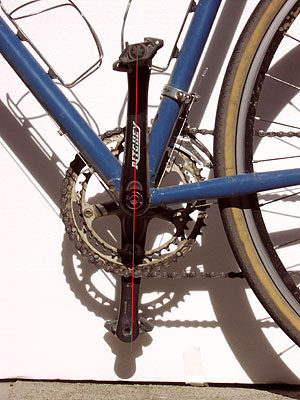
click for bigger than is really necessary.
The image is slightly misleading, as I used the non-drive crank arm as the reference. The drive-side arm is really the one that didn’t move. I could bring the arms in and out of alignment by leveling the cranks and weighting the left - forward equaled out, and back equaled in alignment. After sending this image to Ritchey, they wanted the arm back to see what was wrong. I did so and the day they received it, sent back a detailed email saying that the splines had been misaligned upon installation and that was what allowed the shifting. They also said they’d replace the arm so I could try again.
That was darned nice of them to do that. Honestly, I didn’t agree with their assessment. But, there’s certainly a possibility that my ham-fists and incrementally increasing farsightedness combined to do that. I’ve bent bits, snapped bolts and generally mucked up mechanical adjustments. Just didn’t think I did then.
Now, I did have an unplayed card had they chosen not to replace the replacement. Y’see, this is actually the second time this has happened. The first set I got of these had a similar issue, and as seen here the angle was more dramatic, but I rode more miles before becoming convinced there was an issue - 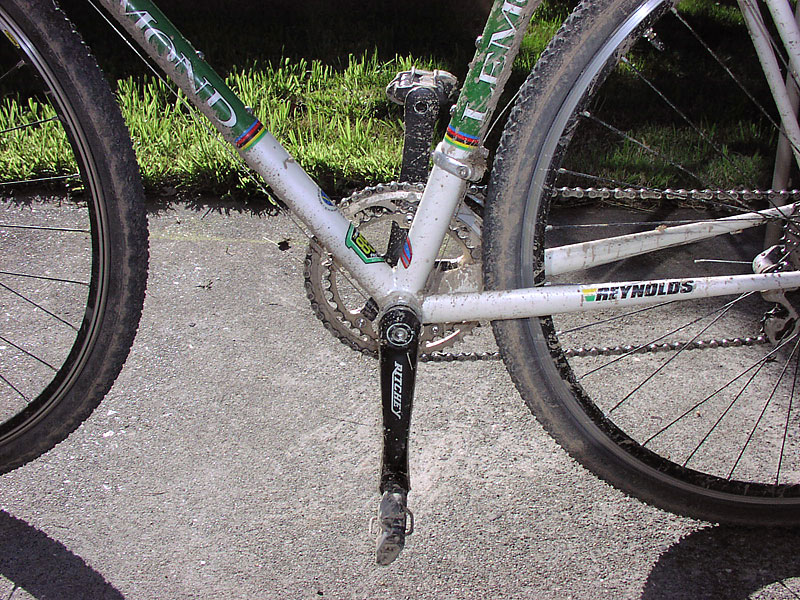
In this instance, Ritchey had dealt very kindly with the situation. The first arm had actually stripped out, and this was the replacement set. They replaced this as well, with the crankarm which ended up snapping. In the case of this arm, it had set easily upon the splines, so there really wasn’t an installation issue. My eyes were better back then, too.
Back to the Future - well, the future of a couple weeks or so ago. The 2nd replacement arm that Ritchey sent fit more easily onto the spindle. Just to make sure, I used the camera to make sure that things lined up before tightening everything down. 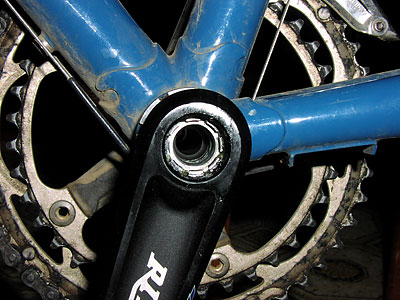
click for bigger than is really necessary, but it does give good detail.
I tried to be extremely mindful about the installation. Got it set into place, checked and double checked and even looked at the photo image onscreen before I put the bolt in and turned it tight.
And that’s pretty much the moment when I thought, “y’know, I really shouldn’t have to go through this to hang a phuh-reakin’ crankarm on my bicycle…”
It got me thinking that small splines are always fiddly little bits, and square tapers are stout simple means to install something. It’s actually easy enough to mount an Octalink crank one spline tooth off, so that the arms end up misaligned. You certainly (well, you certainly should) notice it before you get on and pedal, but it’s darned near impossible to not notice the 90 degree aberration if you did that on a square taper bottom bracket.
In other words, why did Shimano - or any of the manufacturer’s who signed on for the non-compatible ISIS version that came out around the same time - feel it necessary to take a simple working standard and change it?
I expect the answer might have had something to do with CNC-machining, and the boom of the mountain bike market. In the early 90’s, it seemed that anyone with an expired military contract and a machine shop was cranking out bike parts. Cranks were particularly sexy - highly visible, easy to make, easy to make unique looking. Just going to the BikePro crank overview gives 20 or so different manufacturers. My paper catalog shows about 18 pages of cranks, from companies like Kooka, Grove Innovations, Adventure Components, Flite Control, Grafton, Sampson, T-Gear, Sims and TNT. A goodly number of names that surfaced then and have since submerged.
Thing is, groovy-cool CNC’ing from raw billet can lead to some pretty dramatic failures, especially when the raw billet gets swaged onto a tapered connection and then really cranked down. Well made cranks are generally cold-forged, which means that you have to spend the money to make dies and such, but you align the grain of the metal in specific ways, to offset stresses from things like, oh, attaching them to the a tapered spindle and then torquing the heck out of them by pressing the pedals.
My recollection was that the ISIS standard and the Octalink standard came out at the same time, but I’m not sure that’s entirely correct. Maybe what happened was that Shimano wanted to regain the crank business - because at that time, they were really losing ground to non-Shimano cranks (and generally, across the board, on brakes, levers, etc.) - and so unveiled this new design of bottom bracket to make sure people used their cranks. The ISIS may have been a reaction to gain the claimed benefits to the newer BB design - since the larger, hollow spindle was supposed to be - wait for it - stiffer and lighter (lordy, how many times do we need to hear that?). But, I have to believe that setting a CNC’d crank arm into a fitted interface reduced the stresses from installation.
Which is why, some 10 years later, I’m looking at my computer monitor with a magnified image of a greasy splined interface, knowing that I have it lined up properly, but still making sure that I’m removing any variable that could be claimed as my incompetence.
At this point, a couple of rides later, things continue to work as they should. But, I really have not stressed things. In fact, my working plan is to have another moderate ride or two, then remove the arm and check the splines for galling.
That working plan got me thinking about cranks which are actually made these days, because at some point, I’m going to get tired of messing around with this thing, or Ritchey is going to run out of replacement arms for me.
Sugino is the the logical first visit. They have the XD2 which was the original crank on the Hilsen (shown below), and was used on the Quickbeam as well. It’s a very good value for the money, cold forged, silver uses a square taper. There are probably only two things that fall into the negative column for me - they are a hair wider than they need to be (Q-Factor/Tread):
As a non-scale comparison, here’s the same view of an totally different crank on an entirely different bicycle: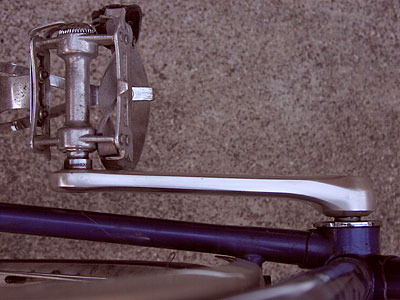
This image was taken of the Dawes, which has narrower rear triangle spacing (hence a slightly straighter angle of the chainstay) and uses an older Shimano 600 series (last year before they renamed it “Ultegra”) road crank.
To inaccurately illustrate the difference, I hand-positioned my XD2 non-drive arm in roughly the appropriate position while balancing the bike and snapping this photo with my other hand: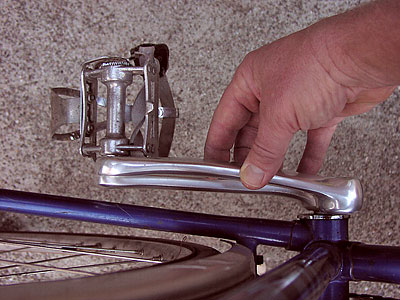
You can at least get a sense that the new/current design will sit further away from the chainstay - necessary if you are designing a crank for more current, shorter wheelbase bicycles which tend to have wider stays. And, I have shown a complete inability to be hampered by slight changes in this area. Some riders may be more directly impacted by it. I get on a wider set of cranks, go “whoa! those are wide!” and then promptly forget about it within the next half hour of riding.
The Sugino XD2’s also use the evil hidden bolt arrangement. The EHB arrangement is peculiar to triple chainring cranks, I think. The first time I came across it was with the Specialized crank (Strongarm? Son of Strongarm? I’m pretty sure it’s out there someone in the parts pile…) that came on my old M2 Stumpjumper. The outer two rings are held on with a standard “sandwich” of outer ring / machined spacer on the crankarms / inner ring. The fifth bolt position is in line with the crankarm itself. At this position, they machined a small gap so that you can fit the threaded nut into position. (I don’t have an image of this detail right now. You’d think, with all the pictures I’ve taken….)
What you end up with is a gap that is a bit too narrow for the chainring bolt tool to get in there. Which means you’ve got to figure out some combination of tools and angles to keep the threaded bit from turning as you torque down the bolt. With the Specialized design, I used to have to shove a rag and screwdriver tip in there. It’s a minor inconvenience, and I seem to overcome the issue. It just always gets me frowning when dealing with it. It seems really slick to integrate the 5th bolt to the arm itself, but just doesn’t work for me.
(As a comparison, the Ritchey Cross Cranks I have use the same hidden 5th bolt design, but just threaded the hole so you use a standard length bolt and go for it. I’ve never had the threading fail, but have had one of those bolts back out on me.)
One design I like is the Sugino Alpina 2 
Simple, silver, 5 exposed bolt design, but with the clever addition of material as “webbing” near the arm itself, presumably to distribute stresses effectively. What Sugino doesn’t indicate is whether or not they have a similar tread width to the XD2’s. Unfortunately, the website doesn’t have anything other than a side view. It’s only possible to guess from the images. There are a few vendors which list the Alpina (or Cospea) which appears to be more expensive. The only domestic “for sale” listing of the Alpina2 had it at ~$125 (significantly less than the Alpina/Cospea), but also says this isn’t available.
Poking around their website again, it appears that Sugino has also added a “Mighty Tour” to their lineup. Hard to say what the differences may be - it does seem to have sharper finishing and may be an actual replacement for the coveted Alpina/Cospea. But, it also seems that sometimes models surface on the Sugino site which don’t migrate into production models.
Returning again to the larger picture, a few years ago, Shimano came up withe the Hollowtech II series, which featured an outboard bearing design and “two-piece” crankset. Basically, this let them run an even larger spindle, which they permanently attached to the right crank arm. The left arm was then attached to the other end (using smaller teeth on the spindle, but wisely using a wider alignment notch which prevented misalignment. The outboard bearing design meant that all of a sudden, facing the bottom bracket of the bicycle frame became important again. It also meant that the chainline gets adjusted by using spacers between the bearings and the frame. You aren’t going to be able to tweak the position of the front chainrings by a few millimeters by getting a shorter bottom bracket spindle.
And, I’m not against this design precisely. Initially, there were a few simple designs, but everyone now seems to be phasing those out in favor of carbon. SRAM, for example, initially brought out a Rival series crank which was silver and looked pretty darned nice and allowed the use of a smaller inner chainring due to the 110BCD. Which of course meant that that they had to change the design, going to a black anodized finish and electing to use a 130BCD (minimim small chainring size of 38T). If silver was the only concern, you can still find their “Cross” crank model around (or the indistinguishable S300 GXP), but again, you are back to using the “road” rings of 130BCD. Everything else in the upper end is a carbon crank.
Which is really off the table for me, as the cranks which I alluded to way back at the beginning of this saga - the ones which failed twice on me - were carbon. More precisely, they were carbon wrapped over an aluminum skeleton. Light and stiff and all carbony, they both failed the same way, going from perfectly fine to “that feels funny” to rubbery, bendy, twist-em-with-your-hand delaminatedness within 15 minutes. Had it not been for the aluminum bones, they would have been useless. As it was, I was lucky enough both times to be relatively close to home.
I know why they failed - it’s simple enough. The resins had not permeated all the layers of carbon - clearly a manufacturing issue. The company (which curiously enough then got out of the crankset business entirely) replaced both pair after each failure, but I never used the third replacement - sold ‘em off (with full disclosure) to someone for whom carbon held a compelling allure and bought the Ritchey Cross cranks.
The companies who are still making carbon cranks have certainly had more than a few manufacturing cycles to shake down their processes. My guess is that they have more weight in resin than they do in carbon, and cranks are probably a reasonable application for the material, as impacts tend to be few, and you can, theoretically make the highest use of the directional nature of carbon. If you are going to hang carbon on your bicycle, it probably makes sense to put it there.
I just don’t really want them on my bike. Or maybe it’s just that I’d like to have a little more choice. Carbon just strikes me more and more like a disposable material. Maybe it’s aesthetics. For me, carbon starts shiny and sleek, but gets ratty when it ages, while to my eye the metals gain a burnished and rubbed finish as the years go by.
When looking back to aluminum, I have to admit that two aluminum crankarms failed on me as well. One was pretty danged old, failed exactly as aluminum tends to - minor warning cracks (which I did not notice), followed by immediate separation. That was the most dangerous example, as I went down reasonably quickly with vehicular traffic behind me. The other was sub-spec material, as I’ve rehashed to death at this point.
All of that strangely points me back to steel. On a set of cranks. Which is about as common in the current market as…well… a set of steel cranks.
What it could let you do, is work with some of the newer, lighter steels, have something which takes impacts well, fails in a slow manner and could look really nice. The only downside would be that they require plating for that snazzy shiny silver look that aluminum does so well. As I poked around the inerwebs, muttering about this and the kids on my lawn, I came across something that fit the bill - 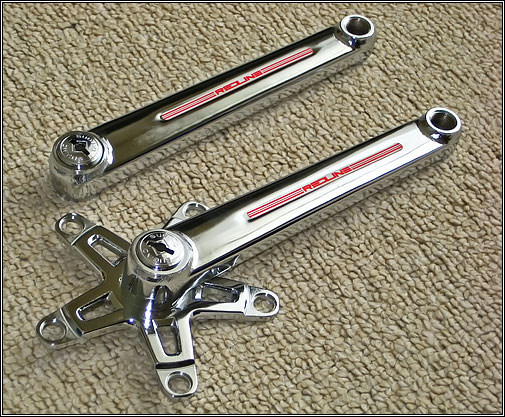
I found this image on Greg Terzian’s blog, with some really interesting historical information. First, these “Redline” Flight cranks were made by…Sugino. Second, as Greg states, “the Sugino 400 drive arm had a 110BCD five-bolt aluminum spider permanently installed.” And, the sharp-eyed among you have already noticed, it’s designed for a traditional square-taper bottom bracket. As his writings mention, these are of course highly coveted by collectors, who probably wouldn’t think of slapping ‘em on a bike and actually using them.
But, if I had some, I’d run ‘em…
December 2nd, 2009 at 9:00 pm What about something like the white industries VBC road cranks?
http://www.whiteind.com/cranks/roadcranks.html
I realize they are still aluminum but they focused on Q-factor (142mm) which has something to be said for it.
December 3rd, 2009 at 12:06 pm Jim, on those Redline Flight cranks —
I’d bet dollars to doughnuts that the chainring spider is swaged onto the drive-side crank, e.g. “aluminum spider permanently installed” — dissimilar metals and all that. I have an old set of Sugino Maxy cranks (http://img188.imageshack.us/i/maxy3.jpg/) on my fixie with a swaged spider, and even under my skinny butt I’ve had problems with creaking. Red Loctite seems to have helped (for now).
I might replace ‘em with a set of RD2s, but I’m confused by chainline choices/issues/options.
December 3rd, 2009 at 12:48 pm all i can say is…long live the square taper!
December 3rd, 2009 at 4:04 pm Ah, found a photo of my Sugino Maxy cranks…
Sanyo BB Generator by jimg
December 3rd, 2009 at 11:19 pm Interesting…
I think because of the dislocated nature of writing this post, I did forget to mention the VBC’s. They are good looking, but I never quite understand if you are then beholden to the White Industries rings.
The other thing I didn’t really expound upon were my old Cook Bros. Racing E2 cranks - they were extremely well rendered, really nicely finished (thought these days, I would have probably stuck with the silver polished finish), but tended to squawk right at the removeable spider.
December 4th, 2009 at 12:03 am You mention them, but I have to reiterate how nice the Rivals are. Picking up a set on ebaby or elsewhere would be a good investment. That said, I have some of the hallowed TA Zephyrs that I really do love. They hit the versatility/looks/weight/Q convergence that is so hard to find anymore. The Sugino XD cranks could do that if they just took 5-10mm of the Q.
December 4th, 2009 at 12:36 am Yeah, those silver Rivals would’ve been a go, even if I’m not entirely trusting that the external BB “standard” will remain so.
December 4th, 2009 at 12:23 pm The Rival cranks use the same GXP BB as Bontrager and Truvativ, and that BB came on a lot of bikes. It fits a standard shell, and I don’t think parts availability will be an issue for quite a while. I’ve got a set of Topline microdrive cranks that creak all the time. I uninstall and look at them very closely, but I guess for now it’s just the spider/arm interface.
There are a bunch of great 94/56 BCD square-taper cranks, but very few that can be set up as a great low-Q double. Suntour XC pro, Shimano XT, Specialized, White Industries, etc. So, that’s what I want. low-Q 94 bcd double. It could come with spacers and holes to allow a 56bcd small ring to be added, but the key is that without them it could be run on a narrower BB.
December 4th, 2009 at 4:52 pm I liked the old Richey Logic a lot…they are on my 1997 All-Rounder, also like the Superbe Pros on my Riv road…liked the Stronlight 93’s and I would have loved to have had the Mavic Mountain cranks (circa 1990-1992)
December 4th, 2009 at 7:13 pm Yes! Those Ritcheys were the ones I wish I’d snagged back when RBW was still offering them…. ahh well.
December 5th, 2009 at 12:43 am Also, RE: spindle interfaces: I’d forgotten all about these, but Grove innovations tried out a trianglular lobe design for the spindle, and now Fifteen.G is trying it again. Apparently it’s based on some actual scientific study of torque transmission, and the Military has used it in numerous axle specifications on tanks, etc. http://www.bikepro.com/products/cranks/grove.shtml http://www.bikemag.com/news/freshproduce/previewed-fifteeng-cranks-and-bottom-bracket/
December 5th, 2009 at 8:02 am Keep watching and you’ll find some of those Ritchey’s for sale. Old XT 110/74 triples aren’t too hard to find either and are very nice.
December 5th, 2009 at 12:06 pm I like the classics, I guess I know it’s been said before, probably, but if anybody could pull off the perfect crank with the magic combination of elegance, strength and light weight, it would be Nitto with their superb sense of design and meticulous attention to detail
December 5th, 2009 at 8:42 pm Why can’t Tom Ritchey revive the old 110 Ritchey Logic cranks? I was convinced of their worth by one of Grant’s writings in an early Reader in the mid-90s and have them on two bikes. The old road double is particularly nice. Picked it up when Excel sports or someone was dumping them because of lack of interest by racer-boy types I guess. Tom, are you listening? Can’t they be revived? I am sure folks would pay a premium.
December 5th, 2009 at 11:46 pm Ryan -
Nitto cranks..mmmmmmm! Don’t know if they have the forging technology under their roof, but I’m sure they could design something pretty spiffy. Or, use their experience with steels to come up with something that way.
Ricardo -
Don’t know… I guess the forging dies eventually wear out, and at some point, you’ve got to make new ones. Maybe that was the “no go” point for the older Ritcheys. But, those were nice cranks, as I said above, should’ve snagged a set when I had the chance.
December 10th, 2009 at 12:16 pm Really good article, thanks for posting it.
Coupla thoughts:
1. The BB30 (aka external BB) system IS becoming a new standard, at least for sport/racing bikes because of light weight AND ease of replacement. I went over to the “dark” side this year when upgrading the cranks and BB on my SS racing bike. The weight difference is astounding, and the performance is smooth and uncluttered. I like these cranks and BB so much that I’m swapping them onto my new racing frame for next year.
2. If you’re not excessively picky about appearance and want a merely decent triple, J&B Importers has a Tourney copy (their item # 21635, “Sunlite Alloy Triple”) that is perfectly adequate for a triple conversion on a used steel frameset. Order it through your local bike shop. Combined with a UN-54 Square taper cartridge BB it works just fine. I have one on my All-Rounder right now and have had NO problems in over 1,000 miles of riding.
3. Based on lagging sales (at least at my shop) of both parts and the tools required to swap them in and out, I think that ISIS and their ilk are on the wane. People are either going back to square taper, or they’re clamoring for BB30. And yes, the tinier, shorter splines of these systems seem to wear out much faster.
December 13th, 2009 at 5:44 pm For what it’s worth, Rival (and Force, and Red…) are in fact available in both standard (130 BCD) and compact (110 BCD) forms. I don’t know how many pre-2009 cranks are left, though.
As for the external bearings, they have their positives and negatives. You wouldn’t be pleased by the Q-factor. On the other hand, the bearing life problem suffered by Octalink and ISIS is mostly resolved, though the new problem of exposure to weather and grit is introduced. I pulled my cranks off a couple of times last winter to clean sand and grime off the bearing seals. Fortunately, those seals appear to do what they’re supposed to do.
Beth H has a really good point about BB30, too. A lot of the buzz around it has to do with stiffness and weight, and the advancements in that that area are real, but unlikely to interest you. It’s been easy to miss the fact that BB30 cranks retain the big bearings, but move them back into the BB shell, which reduces Q-factor considerably and eliminates the exposure problem of external bottom brackets while preserving the advantages (to those who care) of stiffness and light weight.
And on top of that, BB30 cranks and bearings are very simple to work on. But of course, you need a bigger BB shell, which means a new frame, which kind of limits the usefulness of BB30 on your current frames…
December 14th, 2009 at 12:38 am Ha! Well. Yeah. Having to get new frames would be an issue.
I’m not specifically against lightweight parts that don’t break and work well, and do understand that there can be some benefits of going to a larger hollow spindle. It would have been nice to not be a beta tester for the Octalink phase of development, though.
It still seems to me that if the manufacturers are going to support a new standard, they should at least keep a few aluminum cranks in the pipeline. If I could get a nice simple set of polished ones, that would be nice.
“Stiffness” is the buzzword I mostly chafe at. I’m not sure that more than a few percent of cyclists benefit from anything stiffer. Aheadsets were “stiffer”, but really just meant one heckuva lot less sku’s to stock, and a more streamlined assembly process. It gets trotted out with every change to legitimize it as an advancement. Yet, no one has ever demonstrated to me why it’s any better.